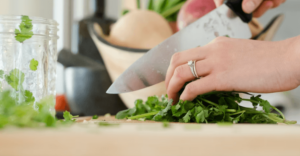We often prepare food mindfully, forgetting the importance of taking our time and focusing on each ingredient. However, when we do take the time to be mindful, we start to notice how much better our food tastes and appreciate all the hard work that goes into it. This article will learn five different ways to be more mindful as you cook your next meal.

Why Do You Need To Prepare Food Mindfully?
There are many reasons why you should prepare food mindfully. The five most important are:
- You will have a better understanding of the ingredients in your meal
- The taste and quality of your food will be improved
- It is easier to cook healthy meals when you take time to appreciate each ingredient
- When cooking becomes an activity that requires reflection, it can become meditative
- Food prepared with love tastes better than anything else!
You will have a better understanding of the ingredients in your meal.
When we are mindful of the ingredients in the foods we prepare, we tend to eat healthier since we are more aware of how the food is affecting our bodies. We all have specific dietary needs and food allergies, so learning to decipher ingredients is very important.
The taste and quality of your food will be improved.
We might not realize it, but eating mindfully makes our meals taste better! When we are in the moment as we eat, savoring each bite instead of scarfing down a meal like there’s no tomorrow, we begin to notice subtle flavors that were previously missed.
We also tend to chew more thoroughly, which allows us to experience all the different textures within dishes. It can even give you insight into how well balanced certain foods are for optimal health benefits.

It is easier to cook healthy meals when you take the time to appreciate each ingredient.
When cooking requires reflection, it can be far easier to be mindful about what you are eating. We can often find ourselves mindlessly reaching for the same ingredients over and over again, without ever stopping to think if this is something that our bodies need or want on a day-to-day basis.
If we take time to reflect before cooking up new dishes, it becomes much more likely to introduce healthier items into our diet instead of falling back onto comfort foods every night out of habit.
When cooking becomes an activity that requires reflection, it can become meditative.
One of the best ways to get in touch with our food and appreciate it entirely is to get creative when cooking. Whether we are chopping, steaming, or roasting ingredients, there are a million different ways to prepare the same dish, each one bringing unique benefits that can be enjoyed by both your palate and well-being.
In addition, food preparation has been used as a meditative practice for centuries because its focus on repetition allows us to become engrossed in what we’re doing without distractions from outside sources.
Food prepared with love tastes better than anything else!
If meals are prepared ahead of time, they’re ready right away once you begin feeling hungry! This might not seem like mindfulness at first glance but keep reading because the act involves slowing down and appreciating your food.
Preparing meals in advance is an excellent way to improve the quality of what you eat throughout the week. It involves cooking up large batches, which can be portioned into smaller servings for easy access later on.

This helps avoid last-minute decisions about buying takeout or making a midnight run through Wendy’s, where we might end up eating something that doesn’t align with our health goals.
Including mindfulness practices in daily life will help you live more mindfully.
The simplest way to add mindfulness exercises into everyday tasks is through simple breathing techniques, which many people overlook but have incredible effects. If you take time to remind yourself to breathe during any given day, you will immediately become more present.
This could be done during your daily commute or even when waiting for the microwave to finish heating dinner. By becoming aware of our breath, we can gain valuable insights into how well relaxed and focused we are in that particular moment, allowing us to make better decisions moving forward.
Everyday Mindfulness Activities To Practice With Food Preparation & Eating
Food preparation can be an excellent way to incorporate mindfulness into life because it focuses on repetition and the rituals that go along with cooking. If we take time to slow down, appreciate each moment as it happens, and engage all of our senses when eating, this will change how we relate to food.
Whether you are getting creative chopping vegetables or simply taste-testing your dish before serving dinner guests, there are endless possibilities for incorporating mindful practices into what you do every day! Try out some of these ideas:
- Pick up ingredients slowly, one by one, while preparing meals
This is good practice for slowing down during dinner time since most people tend to rush through their meals if they’re constantly checking the clock.
- What does each ingredient feel like in your hand?
Taste-testing ingredients can be a great way to get creative with cooking. First, however, we must take time before serving ourselves to think about the different textures and flavors.
- Where does each ingredient come from initially?
This is an excellent question for any meal since most items are shipped across oceans or produced by people who may not have access to clean water or enough food themselves. It can help put our meals into perspective when considering where the components originate!
Use mindfulness practices during mealtimes whenever possible
We could try out concepts such as focusing on how our bodies feel while eating (like the warming sensation of liquid hitting the throat) instead of what everyone else at the table is doing. This may take away from the conversation but will also help us become more aware of how we feel in that moment and eat mindfully.
Take a moment before each bite to appreciate the food – Before putting any item into our mouths, we must pause for just one second so that we can be entirely focused on what is about to happen next.
While this seems like a small step, keeping ourselves present during meals can help avoid overeating later on when distractions overwhelm us.

How Can You Be Mindful When Preparing Food?
Breath awareness is a great mindfulness practice that can be applied to many different activities, including cooking and eating.
For example, when you become aware of your breathing while preparing food, you can focus on the present moment instead of worrying about things outside yourself or inside yourself (such as what’s for dinner).
You will also find that breath awareness helps prevent mindless overeating by allowing the body time to signal fullness before overdoing it with certain foods like those high in fat and sugar.
If you need more motivation for this method, try setting the alarm every ten minutes so that it becomes part of your routine; set another after 30 minutes has passed to ensure you’re aware of your fullness.
Another way to practice mindfulness when preparing food is by visualizing the process from start to finish, including what ingredients are being used and how they will taste afterward.
For example, if you’re making a salad, visualize slicing the vegetables with a knife and putting them together in a bowl before adding vinaigrette dressing on top.
Individuals who have trouble imagining things may find this method difficult, but it can immensely help those who do not struggle with visualization skills.
This technique works best for beginner meditators or younger children because their minds still retain vivid memories about simple tasks like cooking a meal, making it easier to envision the entire preparation from the beginning until the end.
What Is Conscious Eating?
Conscious eating is a form of mindfulness that allows individuals to focus on what they’re putting into their bodies instead of just consuming whatever is available. For this method to work, you must eat with intention and purpose by taking time out before every meal or snack to remind yourself why your choices matter.
If it helps, create a list of pros and cons about each food choice to serve as motivation if anyone feels tempted along the way.
For example: if you want more energy in between meals but feel like having something sweet, you could write down, “if I choose fruit now, then I’ll have enough energy from those vitamins rather than sugar which will cause me to crash.” Conscious eating often focuses on every single bite an individual takes, which is best done with a group of people or alone.
Final Words
In the world we live in today, most of us rarely stop to think about what we’re putting into our bodies unless there are consequences for those poor decisions. For example, it can be difficult to eat mindfully if you have a busy schedule because so many options exist and temptations along the way, but practicing mindfulness while preparing food helps fight off mindless eating by allowing time for your body to signal fullness before going overboard with certain foods.
These methods work well as beginner meditations as they require very little thought process from beginning until end; just follow through! If you find it difficult to visualize, try listening to a guided meditation while preparing food instead.
